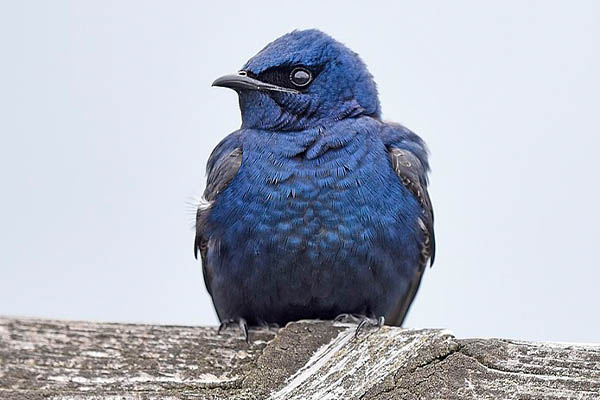
photo credit: VJAnderson, CC BY-SA 4.0 <https://ift.tt/1rWN0uR>, via Wikimedia Commons
The Purple Martin is a beautiful bird that is very sought-after by many backyard owners. People love seeing colonies of these birds that they would set up Purple Martin Houses in their backyards. They are incredible flyers and will eat insects and drink water while in the air.
In this article, we are going to cover a wide variety of topics related to the Purple Martin, such as:
- How to identify them
- How, when, and where they migrate
- Their diet
- How and where they nest
- And much more…
So, without any more delay…
Let’s jump right into it and learn more about the Purple Martin.
Purple Martin Facts
- Common Name: Purple Martin
- Scientific Name: Progne subis
- Scientific Family: Hirundinidae
- Life Span: 5-7 years
- Size: 7.5 to 7.9 inches
- Wingspan: 15.3 to 16.1 inches
- Weight: 1.6 to 2.1 oz
- Conservation status: Least concern
How To Identify A Purple Martin
Purple Martins are the largest swallows in the north of Mexico. They weigh an average of 56 grams and measure around 20.3 cm long. Wings are broad and measure 45.7 cm. These birds are generally dark-colored and have a large, broad chest. Bills are slightly hooked, and tails are short and forked.
Differences Between Male & Female
Adult male and female Purple Martins almost look identical. As the name implies, they both carry a purple color pattern.
Male Purple Martins are covered with an iridescent dark bluish-purple color all over their body, with their wings and tail are brown-black color. On the other hand, adult females have a dull purple color with bits of gray on their head, chest, and belly areas
Differences In Summer Plumage vs Winter Plumage
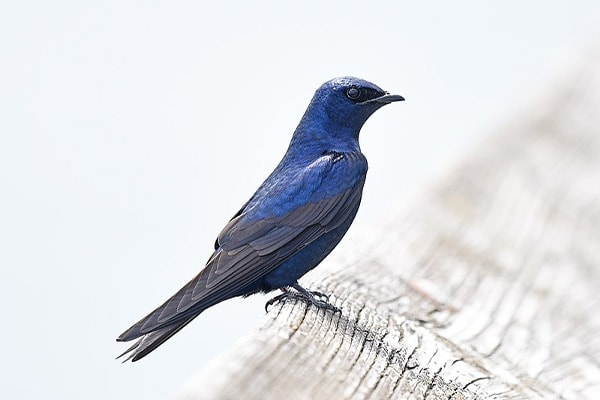
photo credit: VJAnderson, CC BY-SA 4.0 <https://ift.tt/1rWN0uR>, via Wikimedia Commons
Purple Martins look the same throughout the year. However, it has been noted that Purple Martin populations in the southwest United States are lighter in color than the other regions.
Purple Martin Sounds
Where You’ll See A Purple Martin
Purple Martins are widespread birds that can be found across North and South America, breeding in north and central America while wintering in the South.
The birds inhabit the forest edges and rivers in the eastern part of North America, often breeding in woodpecker holes. But most of the time, nest sites are already provided by humans in the backyard.
These birds love staying in open areas where there’s a large body of water. They also don’t stay on elevations of more than 4,000 meters.
Purple Martin Migration Patterns
Purple Martins are long-distance migratory birds breeding in eastern North America. They then migrate across the Gulf of Mexico and sometimes extending towards Central America. Most even winter in the Amazon Basin.
This is their usual timeline:
- In Spring, the birds start arriving between January to May in several states, including Texas, Gulf Coast, Florida, Virginia, Kansas, southern Canada, Arizona, and Montana.
- In Fall, you’ll find the birds in the East passing by around July to September.
- In Winter, you can find the birds in the lowlands of South America.
Diet and Feeding Preferences
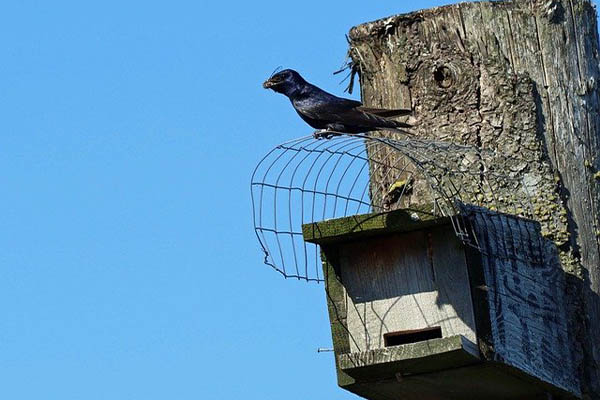
photo credit: JudaM from Pixabay
Purple Martins are insectivores all-year-round. They love eating flying insects in particular. Their menu usually includes beetles, dragonflies, mosquitoes, grasshoppers, crickets, butterflies, wasps, and more. Sometimes, they even feed on spiders.
These birds look for food while flying mid-air. Sometimes, they search for food while flying inches above the water. But when the weather is harsh, and flying is hard, the birds resort to walking on the ground to pick the insects.
Nesting Data
- Clutch Size: 3-6 eggs
- # of Broods: 1-2 broods
- Incubation Period: 15-18 days
- Nestling Period: 27-36 days
- Egg Description: Clear and smooth white
Nesting
Male Purple Martins are the first to reach the breeding grounds to establish nesting territories. They’ll usually find two nest sites the female birds can choose from. The females, on the other hand, choose their mate depending on the nesting site’s quality.
Nest sites are cavities. These are usually built birdhouses, dead trees, buildings, a cliff, or a saguaro cactus. There are also times when nests are also found in traffic lights, dock pilings, and other human-made structures.
Like many other bird species, female Purple Martins make the nest. They usually use green leaves, twigs, grass, sticks, mud, paper, and feathers. Males, on the other hand, gather all the materials and defend their territory.
Purple Martin Behavior
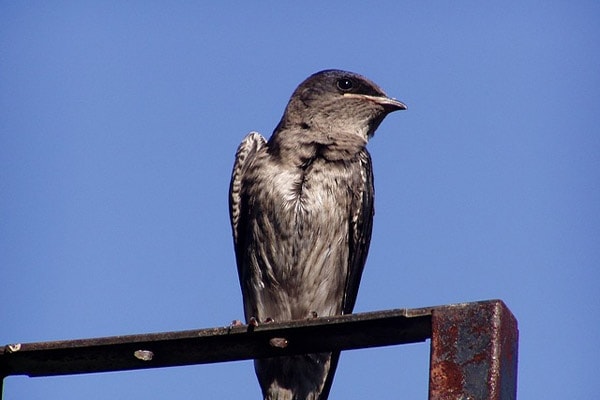
photo credit: jnelson from Pixabay
Purple Martins love living together in large colonies. They migrate together, fly around together, exploring their environment, and even search for food together. This is very interesting because a pair of Purple Martins can be very territorial. However, once they join a colony, they immediately become protective of the colony.
Colonies, as days progress, immediately form this synchronization as they all work together to increase reproductive success. The older and larger the colony, the better they are at showing this sync. And the more the Purple Martins in one colony are of the same age, the better the synchrony is.
Another essential thing to know about Purple Martins is that they can be very aggressive. When they feel a threat, they will peck and flap their wings to tell the intruder to leave. Sometimes, they sing to alert fellow bird species, and sometimes they even do gaping.
Tips for Birdwatchers On How To Attract Purple Martins
Purple Martins start to arrive in summer. And if you’re expecting their arrival in your state, then you should make sure you’ve prepared your backyard.
No bird feeders are needed to be set-up as these birds eat flying insects. But, to ensure that they do have something to it, avoid the use of any insecticides. You can also provide crushed eggshells to supplement their calcium needs while nesting.
Since Purple Martins usually come in colonies and are known for their communal nesting, setting up a Purple Martin house in your backyard is a great idea. Height should only be around 15-20 feet above the ground.
Provide nesting materials all around your backyard for the birds to find. This way, you get to encourage them to stay. Added to that, you can also place some perches all over your backyard.
As for water, birdbaths are not needed. Purple Martins love getting water in natural lakes, ponds, or streams while flying. If you want to provide a water source, something elongated and has a huge space is perfect for the birds.
Threats To The Purple Martin
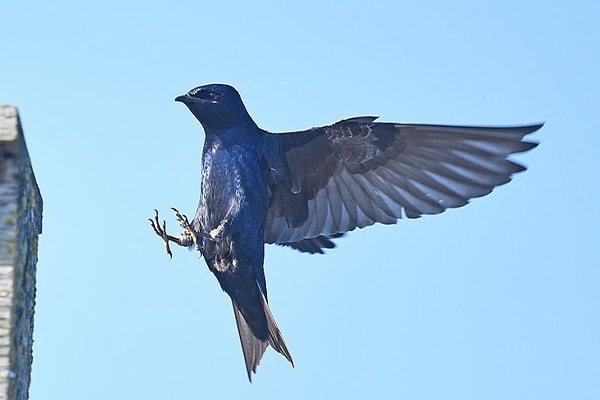
photo credit: VJAnderson, CC BY-SA 4.0 <https://ift.tt/1rWN0uR>, via Wikimedia Commons
Thanks to human efforts by providing nest boxes and shelters for the birds, Purple Martin’s population’s decline has been controlled. However, threats still remain.
Since these birds are insectivores, many of them starve in extended cold weather as they have nothing to eat. They are also very sensitive to cold, which has contributed to their huge decline.
Other than that, cutting off dead trees has also reduced potential habitats for the birds. And it has also been found that other bird species take over their houses and even kill the eggs and nestlings.
Predators are already a given threat, including owls, hawks, magpies, crows, snakes, blue jays, raccoons, and domestic cats.
Fun & Interesting Facts
- Purple Martins are the largest swallow in North America.
- They are not really purple; depending on the light, their feather color can change from bright blue to navy blue to deep purple.
- They are geographically loyal and will return to the same nesting site every year.
- Their greatest enemies are the European Starlings and House Sparrows.
- The oldest recorded Purple Martin lived for 13 years and 9 months.
Explore More Species in This Family
- Northern Rough-winged Swallow
- Tree Swallow
- Violet-green Swallow
- Bank Swallow
- Barn Swallow
- Cliff Swallow
- Cave Swallow
The post Purple Martin: Bird Identification, Habits, Facts, Nesting appeared first on BirdInformer.com.
from BirdInformer.com https://ift.tt/3cRvljI

No comments:
Post a Comment